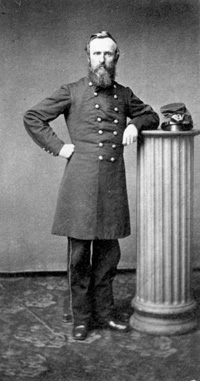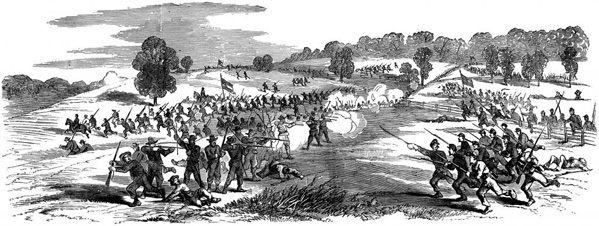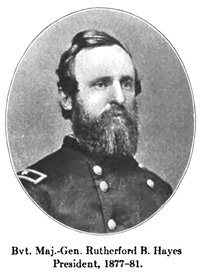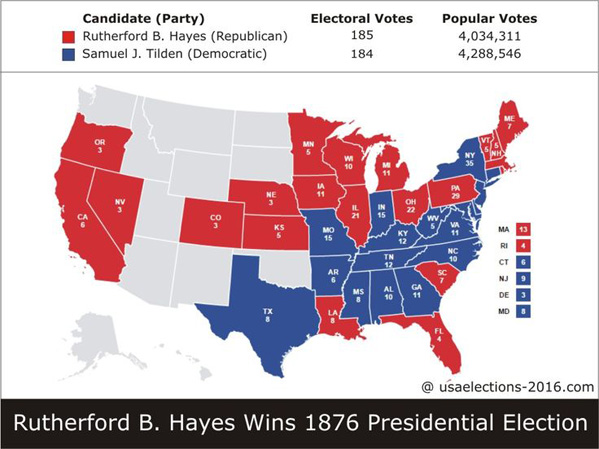
Volume 30, No. 12 – December 2017
Website:
www.CivilWarRoundTablePalmBeach.org
President’s Message:
Thank you to everyone
who re-enlisted and paid their dues.
Your prompt payment is greatly appreciated.
Dues may be paid at the December meeting.
The annual holiday party will be Wednesday, December
13th at 7:00 PM.
Members and their guests are invited to share in a fun evening.
We ask that everyone bring a dish - appetizer, salad, entrée,
dessert - to the meeting.
The knowledgeable and dynamic author, Robert Macomber, will be our
speaker. In December the
raffle is all-inclusive and not limited to Civil War items.
A big ‘thank you’ to Harold Teltser for his donation of a $40.00
gift card to Publix for the December raffle.
Be sure to buy your raffle tickets and you may be the lucky
winner.
Gerridine LaRovere
December 13, 2017
Program:
On December 13, 2017 the CWRT will hold its Holiday Party. Bring a dish
to share. We will once again hear from Robert Macomber. His topic will
be: Blood
Money: The Caribbean's Crucial Role In The Civil War.
November 8, 2017 Program:
 Rutherford Birchard
Hayes was the 19th president.
He can be considered a true public servant.
In order to understand and respect him, one should get a good
general overview and summary of his life.
Hayes was born on October 4, 1822.
He attended Kenyon College where he graduated.
He decided to become a lawyer.
With the help of a wealthy uncle, he attended Harvard Law School.
He had a strong feeling for politics.
In 1844 he cast his first vote for Henry Clay and became active
in the Whig Party. In order
to make a living, his practice would take him to Sandusky, Cincinnati,
and Columbus, Ohio. Rutherford Birchard
Hayes was the 19th president.
He can be considered a true public servant.
In order to understand and respect him, one should get a good
general overview and summary of his life.
Hayes was born on October 4, 1822.
He attended Kenyon College where he graduated.
He decided to become a lawyer.
With the help of a wealthy uncle, he attended Harvard Law School.
He had a strong feeling for politics.
In 1844 he cast his first vote for Henry Clay and became active
in the Whig Party. In order
to make a living, his practice would take him to Sandusky, Cincinnati,
and Columbus, Ohio.
Rutherford married
Lucy Webb on December 30, 1852.
They had seven sons and one daughter.
They are:
Birchard Austin Hayes
1853 - 1926
Webb Cook Hayes 1856 - 1934
Rutherford Platt Hayes 1858 - 1927
Joseph Thompson Hayes 1861 - 1863
George Crook Hayes 1854 - 1866
Fanny Hayes 1866 - 1950
Scott Russell Hayes 1871 - 1923
Manning Force Hayes 1873 – 1874
Hayes was involved
with railroad law. But as a
lawyer in Cincinnati he became a defender of run-away slaves.
Because of this later action he joined the anti-slavery movement
and part of the rise of the Republican party.
When war broke out Hayes joined the army for love of union.
Early on he realized that for the Union to survive slavery must
be stamped out. He had the
rank of colonel, was well liked by the volunteer soldiers he led, and
was wounded four times.
After the war Hayes
was elected to Congress twice and was a three-term governor of Ohio.
Among his accomplishments he established the Ohio State
University and led the passage in Ohio of the 15th Amendment
guaranteeing the vote for all men of all races.
He was the 19th President of the
United States.
First, let us turn to
the Civil War and the 23rd Ohio Regiment.
This regiment was typical of volunteer unit.
The governor appointed the officers and men were from northern
and north-eastern part of the state.
Commanders and officers from these units are rarely mentioned in
the historical record and yet they played the central role in all of the
battles. Hayes was unusual
because he wrote books and articles from the view point of regimental
command. This is important
because we learn how senior commander’s orders were executed.
It gives us insight as to how armies of the period fight, move,
and are supplied. From our
vantage point in the 21st century we are just
beginning to research the non-West Point participants and how they led
the common soldier of the 19th century.
We are now going look
at a series of battles in which Hayes led the Ohio 23rd.
His first real combat was the battle of Carnifex Ferry, where he
was under the command of William Rosecrans.
It is September of 1861.
He led four of the regiment’s companies to the extreme left to
search for the enemy’s right flank.
When found the confederate’s fired and then retreated.
After his introduction to battle, the area which will become West
Virginia settled down into brief exchanges from winter positions.
The Union was under the command of Rosecrans and the Confederates
were under Lee.
Hayes is in a
defensive position in early May of 1862, and is ready for an attack he
knows is coming. When it
came on the 10th his men put up
resistance, but were far too small in number to hold their ground.
Hayes led an orderly retreat to the New River Gorge where he set
up a defense. However, the
enemy brought up artillery and one of the rounds hit Hayes on the knee
giving him a flesh wound.
Rather than being evacuated, Hayes continued to lead him men saying
“Boys it is getting rather hot here.
We better move down.”
This is important because he continues to command, refuses treatment,
and leads his men to safety.
This is the first of four wounds he will receive.
By September Hayes’
regiment is transferred to Maryland in the days before the battle of
Antietam. He is part of the
corps that is attacking Fox’s Gap.
He is leading when he is struck down by a second wound to his arm
above the left elbow. While
lying in the field he is instructing his men to move forward.
It is interesting to note that he is next to a wounded
confederate soldier to which he strikes up a friendly conversation.
He asks this man to contact his wife with a message if he should
die there. He does his duty
as a soldier, but bares no malice towards the enemy.
From this point until the following June Hayes is recovering from
his wounds.
By June of 1863, when
West Virginia becomes a state, Hayes is back with the 23rd and operating in the
new state. His orders are to
cut rail communication that the South is using to supply Morgan in the
area to the north and into Ohio.
Morgan is moving all around Kentucky, Ohio, and West Virginia.
Hayes meets Morgan at Pomeroy on the Ohio River and could have
fought him there, but did not.

In May of 1864 Hayes
is operating in western Virginia near Dublin.
He was involved in a small, but successful frontal assault.
Rather than stopping to consolidate his force and seek help from
higher command, he resolves to attack to keep the momentum of victory
going. Believing he was
outnumbered he resorted to deception by having his men yell like they
were of great strength. Not
only did this shake the enemy, but it brought reinforcements from Crook,
the commander. Note all of
the principle of war that Hayes, the untrained military commander,
demonstrates.
In the summer, Hayes
was part of the unsuccessful efforts of Hunter to rid the valley of
Jubal Early. In July near
Winchester, VA, the Ohio 23rd was ordered to stop
Early’s advance by preventing a flanking move on the Union right.
He received his third wound from a spent ball while giving orders
on horseback.
On August 7th Sheridan was given
command. He moves into
Strasburg to the south to cut off Early’s retreat south.
Our story takes place a few weeks later on Opequon Creek outside
of Winchester. The
aggressive Sheridan is trying to flank Early, but the southern commander
drives a wedge into the center of Sheridan formation.
As Sheridan’s line stabilizes and the attackers have put in all
their reserves, Sheridan drives at opposite flank of the opening attack.
Hayes is part of this counter attack and the ranking officer.
He is in direct control of no more than 1,200 men, but in the
battle the whole army’s fate depends on this single colonel.
Following his orders, and shouting “come on boys,” he rides into
the center of the creek.
When his horse gets stuck in the center of the stream, he dismounts and
charges across the water.
When his division commander is wounded, he is now the commander of the 2nd Division.
Supported by a division of cavalry, Hayes carries the day.
Although COL RB Hayes is responsible, he gives the credit to
General Crook. There was one
more battle in this area in which he took part.
Hayes was given a
division after these fights.
In October, Hayes fought his last battle.
At Cedar Creek his was positioned in a poor defensive spot.
When the fighting began he received his forth wound from a spent
ball. Although criticized
for his action, after the battle Crook came to his headquarters and
promoted him to brigadier general.
After the war he served in Congress and was governor
of Ohio. In 1876 he was the
Republican candidate for President.
After a very bizarre election Hayes beat Tilden by gaining 20
electoral votes by way of a compromise.
Hayes would become president and the north would end
reconstruction in the south.

The compromise essentially stated that Southern
Democrats would acknowledge Hayes as president, but only on the
understanding that Republicans would meet certain demands. The following
elements are generally said to be the points of the compromise:
1/ The
removal of all U.S. military forces from the former Confederate states.
At the time, U.S. troops remained in only Louisiana, South Carolina, and
Florida, but the Compromise completed their withdrawal from the region.
2/ The
appointment of at least one Southern Democrat to Hayes' cabinet. (David
M. Key of Tennessee was appointed as Postmaster General.)
3/ The
construction of another transcontinental railroad using the Texas and
Pacific in the South (this had been part of the "Scott Plan," proposed
by Thomas A. Scott of the Pennsylvania Railroad; he had initiated
negotiations resulting in the final compromise).
4/
Legislation to help industrialize the South and restore its economy
following Reconstruction and the Civil War.
5/ The
right to deal with blacks without northern interference.
In exchange, Democrats would accept the Republican
Hayes as president by not employing the filibuster during the joint
session of Congress needed to confirm the election.
After the Compromise, a few Democrats complained loudly that
Tilden had been cheated. There was talk of forming armed units that
would march on Washington, but President Grant was ready for that. He
tightened military security, and nobody marched on Washington.
Hayes was peacefully inaugurated. Points 1 and 2 of
the compromise took effect. Hayes had already announced his support for
the restoration of "home rule," which would involve federal troop
removal, before the election. It was not unusual, nor unexpected, for a
president, especially one so narrowly elected, to select a cabinet
member favored by the other party. Points 3 and 4 were never enacted; it
is possible there was no firm agreement about them.
Whether by informal deal or simply reassurances
already in line with Hayes's announced plans, talks with Southern
Democrats satisfied the worries of many. This prevented a Congressional
filibuster that had threatened to extend resolution of the election
dispute beyond Inauguration Day 1877.
It is interesting to note that Hayes and Monroe would
be the only presidents to be wounded in army service.
The Ohio 23rd would send two of
its members to the White House, McKinley and Hayes.
Last changed: 11/29/17
Home
About News
Newsletters
Calendar
Memories
Links Join
|

